Introduction
The Neil Armstrong Air & Space Museum (NAASM) is one of over 60 historical
sites in the state of Ohio operated by the Ohio Historical Society (OHS). In
the year 2000 a group of volunteers who had been operating the "Big Ear"
radio telescope (destroyed by land developers in 1998) met with several staff
people of OHS to discuss the possibility of donating historical artifacts from
the Big Ear. The Ohio Historical Center in Columbus, Ohio agreed to keep the
computer printout showing the famous "Wow!" signal. Also, the Director of the
Neil Armstrong Air & Space Museum said that they would create an appropriate
display celebrating the Big Ear radio telescope and the "Wow!" signal. Photos
of that display were taken in November 2001 and are shown below.
Directions
The NAASM is located in western Ohio. The full address and phone numbers are:
Neil Armstrong Air & Space Museum
500 South Apollo Drive
Wapakoneta, Ohio 45895-0978
The phone numbers are: 800-860-0142 and 419-738-8811.
NAASM is located just west of Interstate 75 at Exit 111 (Bellefontaine
Street). Note that Exit 111 is just north of U.S. Route 33 intersection with
Interstate 75.
The Big Ear Display
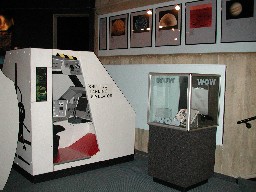
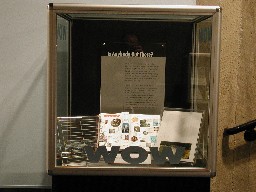 When Dr. Ehman visited the Neil Armstrong Air & Space Museum (NAASM) in
November 2001, he saw their display about the Big Ear radio telescope and the
"Wow!" signal located in a display case near the Shuttle Landing Simulator
(see the leftmost photo). The front panel of the display case had the word
"WOW" pasted on it (see the rigthmost photo).
When Dr. Ehman visited the Neil Armstrong Air & Space Museum (NAASM) in
November 2001, he saw their display about the Big Ear radio telescope and the
"Wow!" signal located in a display case near the Shuttle Landing Simulator
(see the leftmost photo). The front panel of the display case had the word
"WOW" pasted on it (see the rigthmost photo).
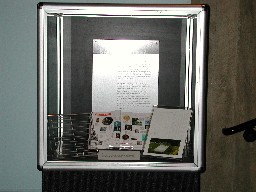
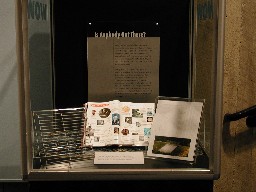 Dr. Ehman asked the Director of NAASM if he were willing to remove the front
glass so that pictures could be taken; that he did. The two photos shown here
(as well as the other photos shown below) were taken with that front glass
removed. The leftmost photo was taken using flash, and the rightmost photo was
taken without flash. Both photos leave something to be desired. The flash
glared off the clear protective covering in the central portion of the display.
On the other hand, usiing no flash caused some portions of the display to have
poor visibility.
Dr. Ehman asked the Director of NAASM if he were willing to remove the front
glass so that pictures could be taken; that he did. The two photos shown here
(as well as the other photos shown below) were taken with that front glass
removed. The leftmost photo was taken using flash, and the rightmost photo was
taken without flash. Both photos leave something to be desired. The flash
glared off the clear protective covering in the central portion of the display.
On the other hand, usiing no flash caused some portions of the display to have
poor visibility.
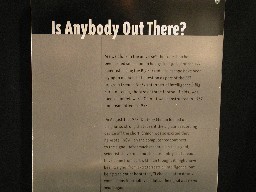 The central portion of the display has some text relating the question:
"Is Anybody Out There?" to the narrowband search program at the Big Ear and
its detection of the "Wow!" signal. Note that the narrowband search program
included the Search for Extraterrestial Intelligence (SETI) but had the
capability of detecting any natural narrowband signals as well (e.g., the
spectral line of neutral hydrogen - it could have detected others as well if
the frequency of observation were changed).
The central portion of the display has some text relating the question:
"Is Anybody Out There?" to the narrowband search program at the Big Ear and
its detection of the "Wow!" signal. Note that the narrowband search program
included the Search for Extraterrestial Intelligence (SETI) but had the
capability of detecting any natural narrowband signals as well (e.g., the
spectral line of neutral hydrogen - it could have detected others as well if
the frequency of observation were changed).
 The January 2000 issue of National Geographic magazine had an article
(starting on page 24) entitled "Life Beyond Earth" written by Joel Achenbach.
On pages 38 & 39 there was a section with the title "Are We Alone? - A Human
History of Wondering Who or What Is Out There". The display case contained a
copy of that National Geographic issue opened to those two pages.
The January 2000 issue of National Geographic magazine had an article
(starting on page 24) entitled "Life Beyond Earth" written by Joel Achenbach.
On pages 38 & 39 there was a section with the title "Are We Alone? - A Human
History of Wondering Who or What Is Out There". The display case contained a
copy of that National Geographic issue opened to those two pages.
 Both the flat reflector and the paraboloidal (curved) reflector of the former
Big Ear radio telescope were constructed of steel wire mesh. This photo shows
a section of that mesh taken just before the telescope was destroyed by land
developers in 1998. This mesh acted as a mirror to the radio waves even
though we can see right through it visually. This is because the wavelengths
of any visible light photon is much smaller than the spacing of the wires in
the mesh. On the other hand, at the radio wavelengths we were using in our
observing programs on the Big Ear, the wavelengths of those radio photons were
much larger than the spacing of the wires, so the mesh acted as a reflector
(mirror).
Both the flat reflector and the paraboloidal (curved) reflector of the former
Big Ear radio telescope were constructed of steel wire mesh. This photo shows
a section of that mesh taken just before the telescope was destroyed by land
developers in 1998. This mesh acted as a mirror to the radio waves even
though we can see right through it visually. This is because the wavelengths
of any visible light photon is much smaller than the spacing of the wires in
the mesh. On the other hand, at the radio wavelengths we were using in our
observing programs on the Big Ear, the wavelengths of those radio photons were
much larger than the spacing of the wires, so the mesh acted as a reflector
(mirror).
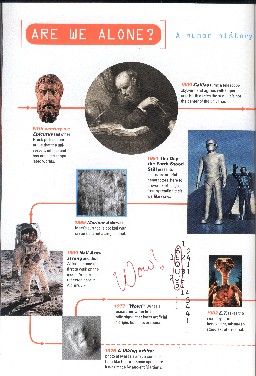
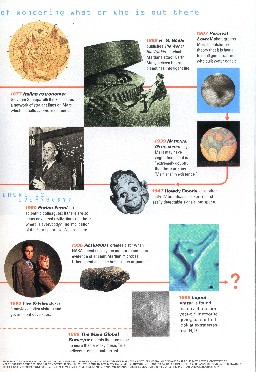 Here are pages 38 & 39 of the January 2000 issue of National Geographic
magazine. I suggest that you click on each image to obtain a larger version
for easier viewing.
Here are pages 38 & 39 of the January 2000 issue of National Geographic
magazine. I suggest that you click on each image to obtain a larger version
for easier viewing.
 When Dr. Ehman saw the sequence "6EQUJ5" on the computer printout, he knew
very quickly what he was seeing, and being quite astonished at seeing the
strongest narrowband signal he had ever seen, he wrote "Wow!" in red pen in
the margin of the computer printout. This photo is a copy of the relevant
portion of that computer printout. [Note. The meaning of "6EQUJ5" is available
by going to menu item on the home page of this website dealing with the "Wow!"
signal.
When Dr. Ehman saw the sequence "6EQUJ5" on the computer printout, he knew
very quickly what he was seeing, and being quite astonished at seeing the
strongest narrowband signal he had ever seen, he wrote "Wow!" in red pen in
the margin of the computer printout. This photo is a copy of the relevant
portion of that computer printout. [Note. The meaning of "6EQUJ5" is available
by going to menu item on the home page of this website dealing with the "Wow!"
signal.
 The National Geographic magazine refers to a "researcher" in this caption
without identifying who that researcher is. Of course, it is Dr. Ehman.
The National Geographic magazine refers to a "researcher" in this caption
without identifying who that researcher is. Of course, it is Dr. Ehman.
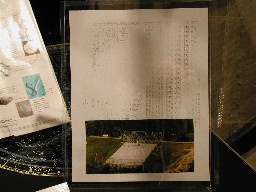
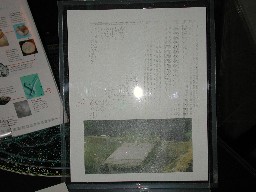 These two photos show another portion of the display. The leftmost photo was
taken in ambient light while flash was used for the rightmost photo. Of
course, glare of the flash detracts from the second photo. This portion of the
display shows (although not very well due to the difficulty of obtaining a
good-quality photo) a copy of the full page of the computer printout and,
below that, an aerial photo of the Big Ear radio telescope.
These two photos show another portion of the display. The leftmost photo was
taken in ambient light while flash was used for the rightmost photo. Of
course, glare of the flash detracts from the second photo. This portion of the
display shows (although not very well due to the difficulty of obtaining a
good-quality photo) a copy of the full page of the computer printout and,
below that, an aerial photo of the Big Ear radio telescope.
Outdoor Pictures
The three photos below show the NAASM building in the distance and the
entrance to that building (in the third photo in the sequence).
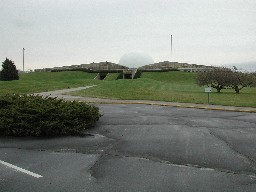
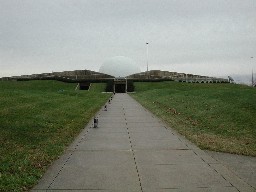
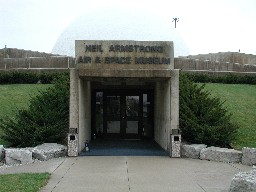
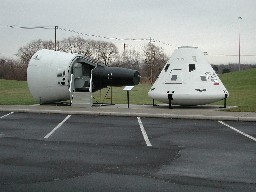
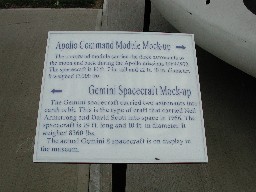 A mock-up of a Gemini Spacecraft and a mock-up of an Apollo Command
Module are located outside the building. The second photo shows the text on
a plaque describing these two mock-ups.
A mock-up of a Gemini Spacecraft and a mock-up of an Apollo Command
Module are located outside the building. The second photo shows the text on
a plaque describing these two mock-ups.
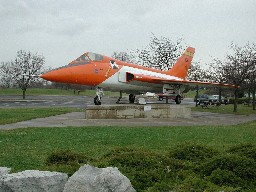
 Near the parking lot is this Douglas F5D Skylancer that Neil Armstrong
flew. The plaque provides information about this.
Near the parking lot is this Douglas F5D Skylancer that Neil Armstrong
flew. The plaque provides information about this.
![[Aerial Photo of Big Ear]](../../bigearhp.gif)
![[Aerial Photo of Big Ear]](../../bigearhp.gif)
![[NAAPO Logo]](../../NAAPOsm.jpg)